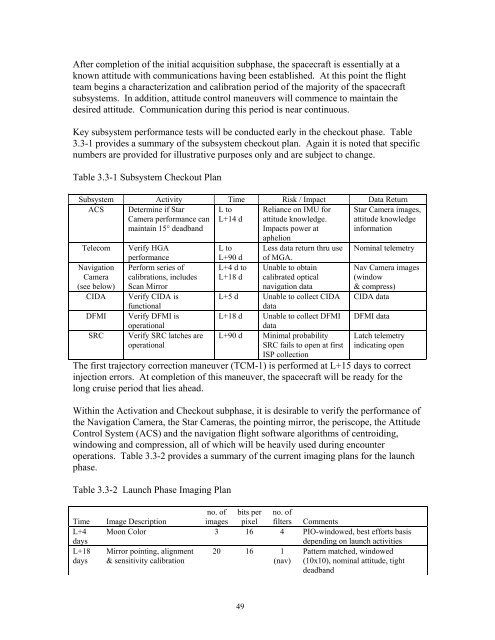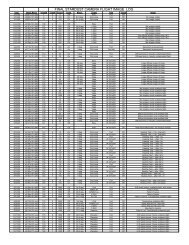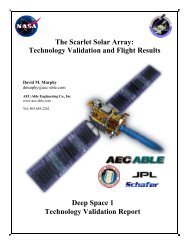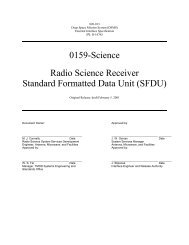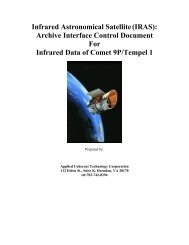MISSION PLAN - PDS Small Bodies Node
MISSION PLAN - PDS Small Bodies Node
MISSION PLAN - PDS Small Bodies Node
Create successful ePaper yourself
Turn your PDF publications into a flip-book with our unique Google optimized e-Paper software.
After completion of the initial acquisition subphase, the spacecraft is essentially at a<br />
known attitude with communications having been established. At this point the flight<br />
team begins a characterization and calibration period of the majority of the spacecraft<br />
subsystems. In addition, attitude control maneuvers will commence to maintain the<br />
desired attitude. Communication during this period is near continuous.<br />
Key subsystem performance tests will be conducted early in the checkout phase. Table<br />
3.3-1 provides a summary of the subsystem checkout plan. Again it is noted that specific<br />
numbers are provided for illustrative purposes only and are subject to change.<br />
Table 3.3-1 Subsystem Checkout Plan<br />
Subsystem Activity Time Risk / Impact Data Return<br />
ACS Determine if Star<br />
Camera performance can<br />
maintain 15° deadband<br />
L to<br />
L+14 d<br />
Reliance on IMU for<br />
attitude knowledge.<br />
Impacts power at<br />
Star Camera images,<br />
attitude knowledge<br />
information<br />
aphelion<br />
Telecom Verify HGA<br />
L to Less data return thru use Nominal telemetry<br />
Navigation<br />
Camera<br />
(see below)<br />
CIDA<br />
DFMI<br />
SRC<br />
performance<br />
Perform series of<br />
calibrations, includes<br />
Scan Mirror<br />
Verify CIDA is<br />
functional<br />
Verify DFMI is<br />
operational<br />
Verify SRC latches are<br />
operational<br />
L+90 d<br />
L+4 d to<br />
L+18 d<br />
of MGA.<br />
Unable to obtain<br />
calibrated optical<br />
navigation data<br />
L+5 d Unable to collect CIDA<br />
data<br />
L+18 d Unable to collect DFMI<br />
data<br />
L+90 d Minimal probability<br />
SRC fails to open at first<br />
ISP collection<br />
Nav Camera images<br />
(window<br />
& compress)<br />
CIDA data<br />
DFMI data<br />
Latch telemetry<br />
indicating open<br />
The first trajectory correction maneuver (TCM-1) is performed at L+15 days to correct<br />
injection errors. At completion of this maneuver, the spacecraft will be ready for the<br />
long cruise period that lies ahead.<br />
Within the Activation and Checkout subphase, it is desirable to verify the performance of<br />
the Navigation Camera, the Star Cameras, the pointing mirror, the periscope, the Attitude<br />
Control System (ACS) and the navigation flight software algorithms of centroiding,<br />
windowing and compression, all of which will be heavily used during encounter<br />
operations. Table 3.3-2 provides a summary of the current imaging plans for the launch<br />
phase.<br />
Table 3.3-2 Launch Phase Imaging Plan<br />
Time<br />
L+4<br />
days<br />
L+18<br />
days<br />
Image Description<br />
no. of<br />
images<br />
bits per<br />
pixel<br />
no. of<br />
filters Comments<br />
Moon Color 3 16 4 PIO-windowed, best efforts basis<br />
depending on launch activities<br />
Mirror pointing, alignment 20 16 1 Pattern matched, windowed<br />
& sensitivity calibration<br />
(nav) (10x10), nominal attitude, tight<br />
deadband<br />
49


